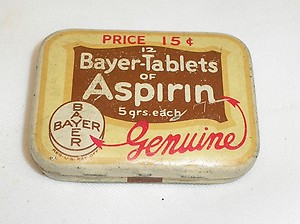 Everyone loves aspirin. The miracle drug that we first go to for headaches, pains, fever, and so on. But where did it come from?
Everyone loves aspirin. The miracle drug that we first go to for headaches, pains, fever, and so on. But where did it come from?
Aspirin, in it’s natural form salicylic acid, has actually been used for thousands of years. The ancient Egyptians used plants containing the acid to relieve pain. With that big gold head old Tut had, he probably had some pretty big headaches.
The natural form of aspirin was so horrible tasting it would cause people to vomit. So now not only did you have a headache, but you’d have an awful taste in your mouth and a vomit stained carpet.
In 1897 German Scientist Felix Hoffman was the first to turn salicylic acid into what we know as aspirin today. Two years later aspirin was patented and trademarked by German drug maker Bayer.
For the next couple of decades all Aspirin came from Germany. But when World War I started, a worldwide Aspirin shortage occurred. The allies became desperate for the medicine and offered rewards to anyone who could replicate the pain reliever.
When World War I ended, Germany was forced as part of their surrender to give up their patent. This paved the way for any company who wished to made their own generic form of the drug. Now you can buy aspirin cheap and it the most popular drug of all time.

Bonus Facts:
I’m sure you’ve heard that Aspirin can help prevent heart attacks. This was first discovered in the 1940s when children who had tonsillectomies were given aspirin-laced chewing gum (yum!). They were observed to bleed more than those who didn’t get the gum. It was reasoned that if aspirin could cause bleeding it could prevent clotting. It wasn’t until the 1970s that this theory was put to tests and doctors began recommending the drug to be used in this way.
Aspirin wasn’t the only drug Bayer was forced by the United States to give up it’s patent on. Heroin also became a generic drug. Think how much we’d have to pay to shoot up if Bayer was still the only company making it!



